A Private Tour today in North Norfolk. It was a rather grey morning, with a moderate and rather blustery east wind, but dry and fairl. the wind dropped in the afternoon and the sun even came out for a time!
Our main target for the morning was to see a Shorelark, so we headed straight round to Holkham first. When we got to Lady Anne’s Drive, the grazing meadows either side seemed rather quiet today. There were no ducks around the pools and no Wigeon out on the grass. A pair of Greylags and an Egyptian Goose flew over, but there were not many Pink-footed Geese out here this morning. A lone Brent was feeding on the grass close to the Drive.
We decided to head straight out towards the beach. Just before we got to the pines, we stopped to scan the hedges either side and we could see several Blackbirds flying back and forth across one of the ditches, between the hawthorns which are still laden with berries. These are presumably migrants which have stopped here to refuel.
On the other side of the pines, we could see a lot more Brent Geese out on the saltmarsh. Most were regular Dark-bellied Brents but in with them was our old friend, the Black Brant hybrid, noticeably darker, with a slightly more contrasting white flank patch and more striking white collar. The fact that it returns here each winter shows just how site faithful all these Brent Geese are.
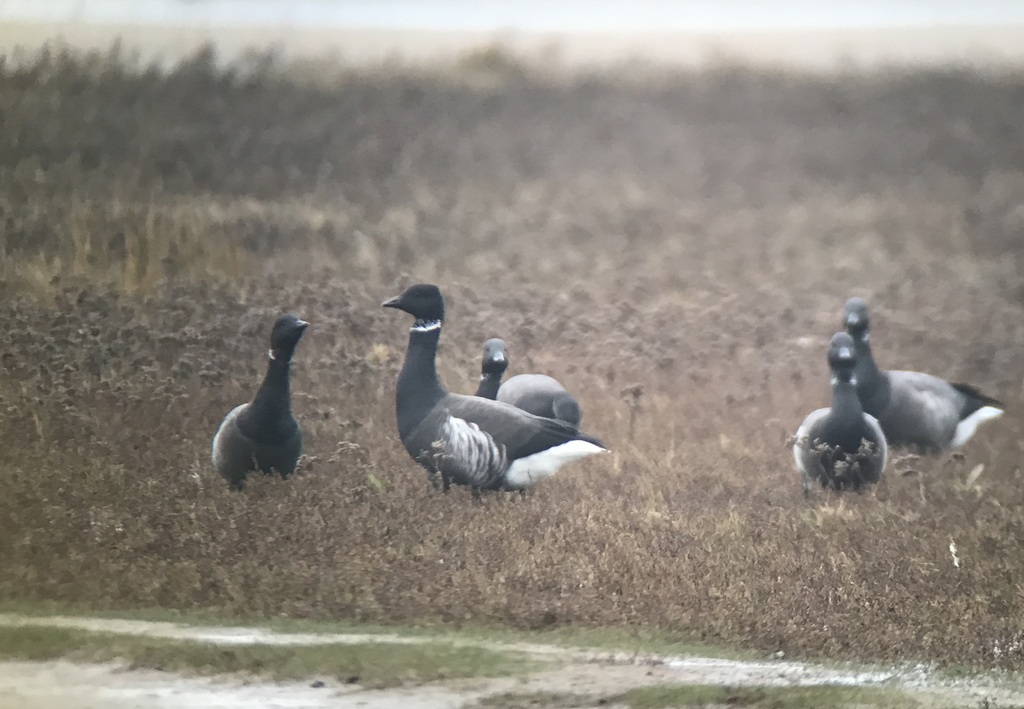
The saltmarsh was very wet this morning, as there had been a big spring tide overnight. There had been comparatively few reports of the Shorelarks in the last couple of days, perhaps as a consequence of the tides, and when we got to the area which has been cordoned off for them, we found lots of standing water and no larks! They were clearly going to take a bit more finding today.
We headed straight on to the beach, picking our way round the pools and puddles. The beach itself was also rather quiet, with fewer gulls than recently and a distinct lack of waders, despite the comparative lack of dog walkers out on the sand today. The Cormorants were standing out on the sand off Wells Harbour today. It was much windier than the last few days, which perhaps was the reason for the relative dearth of birds.
The sea was rather choppy out in the bay, but we did manage to find a few things out here. A line of Eider were riding the waves, and we found a group of Common Scoter further out. Several Red-throated Divers flew past, as did a few Gannets. A Guillemot just offshore was hard to see as it was diving constantly.
We were just wondering which way to go, when a large group of walkers appeared round the dunes from the Wells direction. They didn’t seem to be flushing anything ahead of them and we figured it was unlikely there would be any birds left on the beach that way. So we walked west instead.
There was nothing on the beach or along the edge of the dunes ahead of us. We kept stopping to scan and looking out to sea. We did find three Slavonian Grebes in a group just offshore, which was a very nice bonus. We decided to try along the edge of the saltmarsh, on the inland side of the dunes where it was more sheltered, and we flushed a large flock of Linnets which was slightly more promising. But there was still no sign of any Shorelarks.
When we got to the Gap, we started to walk back out onto the beach. We noticed some movement on the stones ahead of us, around the corner of dunes and looked across to see Shorelarks. Success! They were moving fast over the stones, or flying round in twos and threes, chasing each other. We got them in the scope and managed to see their distinctive yellow faces with black bandit masks before they took off and flew, heading away across the beach and over the dunes other side. We counted at least 20 Shorelarks again as they flew off.
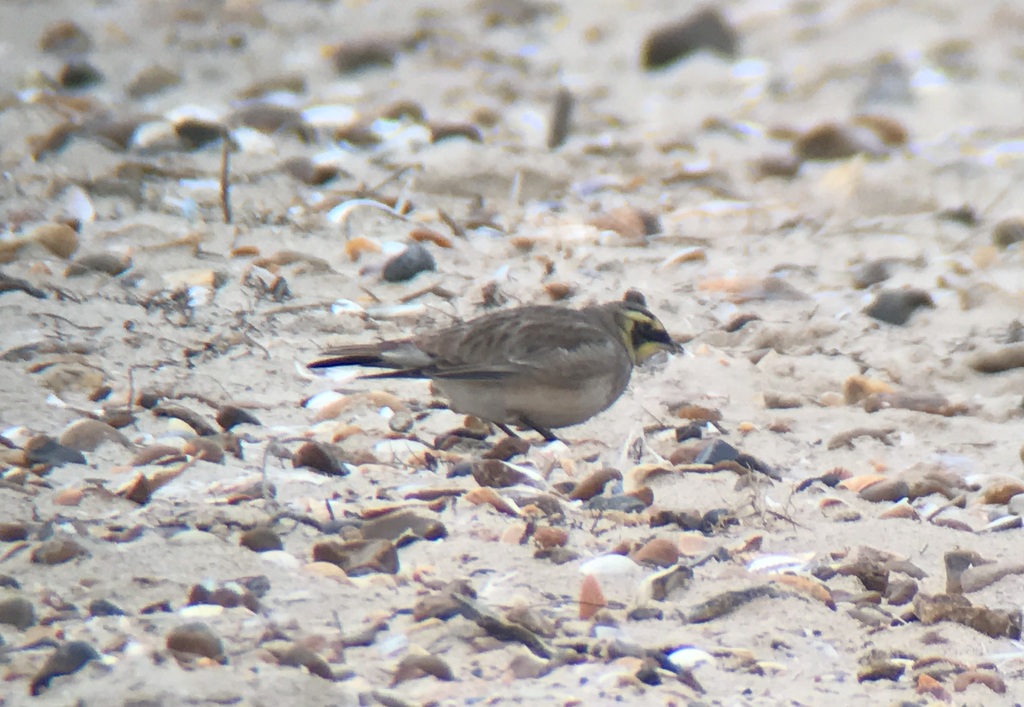
There was still a lot of water draining off the saltmarsh. We thought about crossing to the other side of the Gap but when we got half way over we found that we couldn’t all get across the channel flowing out across the beach without getting wet feet. So we turned to head back the way we had come, and as we did so the Shorelarks flew in again and landed back where they had been.
We stood and watched the Shorelarks again, feeding on the stones. There didn’t seem to be much food here for them, but presumably there were seedheads from the saltmarsh in the sand. They gradually worked their way along the beach away from us, so we decided to leave them to it and head back along the other side of the dunes.
Back at Lady Anne’s Drive, lots of Pink-footed Geese were now dropping in to the grazing marshes, so we stopped for a good look at them through the scope. It had taken a bit of time to find the Shorelarks today, but with our main target in the bag, we decided to explore the coast to the west, looking for waders and wildfowl, taking in the reserve at Titchwell. As we drove west along the coast road, we saw a couple of Red Kites hanging in the air over the fields.
There was still an hour or so before lunch, so we figured we would explore a couple of the harbours before going to Titchwell. At Brancaster Staithe, the tide was out and there were lots of Brent Geese bathing in the channel or loafing around on the sand beyond. A large group of Teal was asleep on the mud bank, and Wigeon were liberally scattered around the harbour.
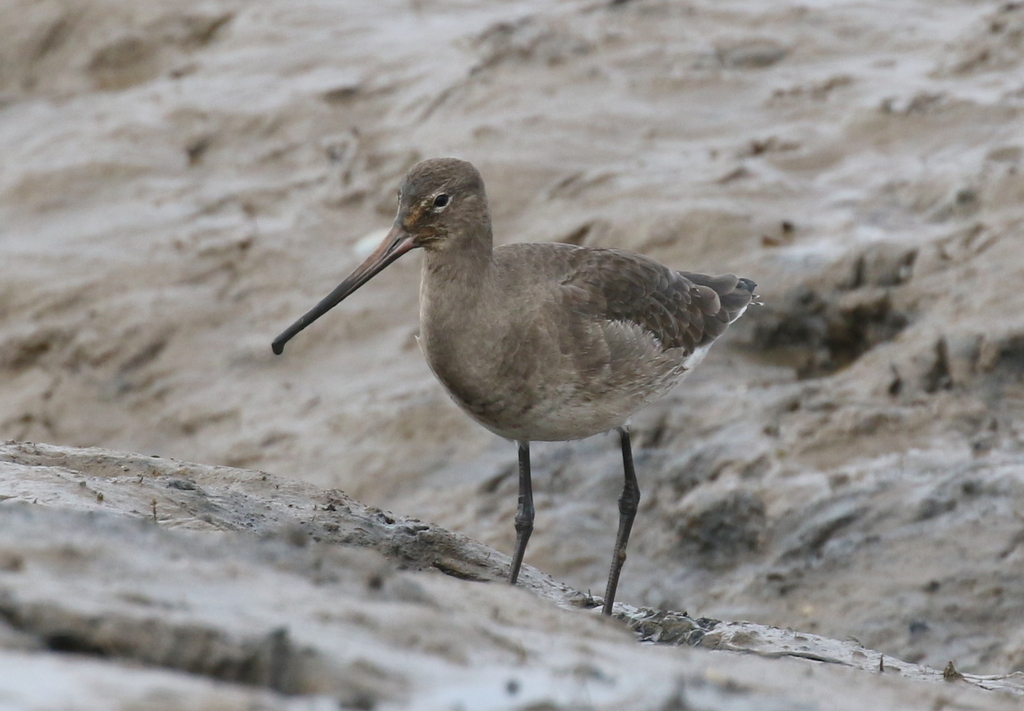
There were a few waders, but still not so many as there are usually through the winter. A couple of Black-tailed Godwits were wading in the thick mud, there were several Redshanks further up the channel and three Oystercatchers were roosting by the water. A Curlew picking around on the mud dwarfed a Dunlin next to it. A Turnstone flew in and started feeding on the piles of discarded mussels.
Our luck was in when we got to Thornham Harbour. As we drove up along the road, a flock of small birds flew across in front of us and landed on the top of one of the wooden jetties. They were Twite, fourteen of them, and there looked to be three colour-ringed birds in with them too.
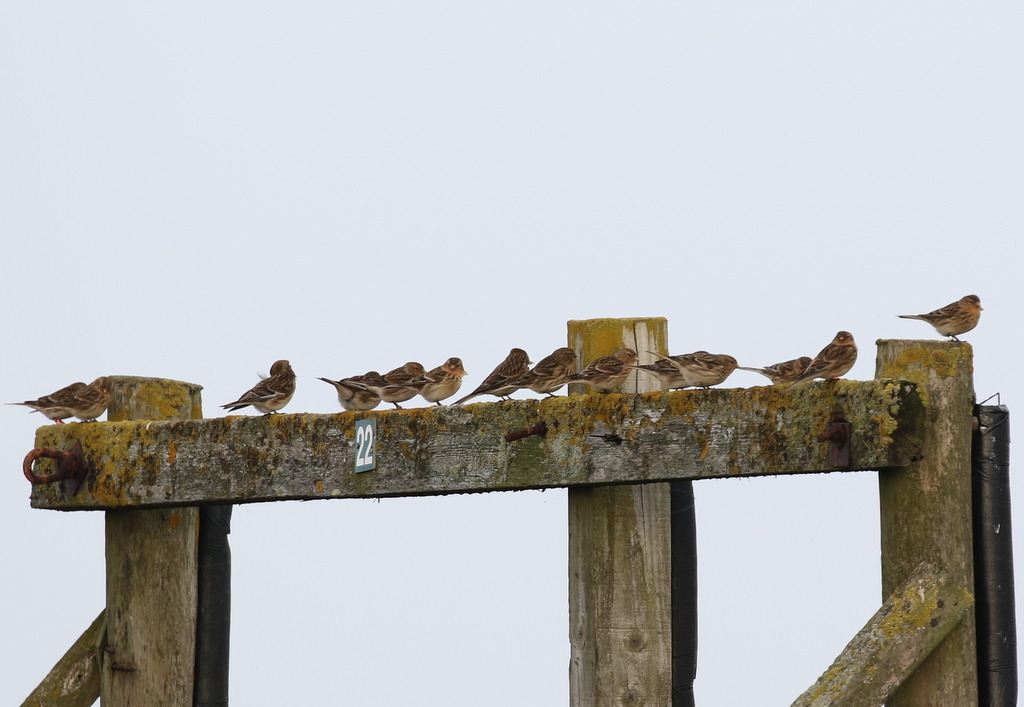
We parked the car and got out very quietly, so as not to disturb them. We got the Twite in the scope from here, noting their orangey breasts and yellow bills. They dropped down one by one to the vegetation below, to feed, and we walked over very slowly for a closer look, to try to get the colour ring combinations.
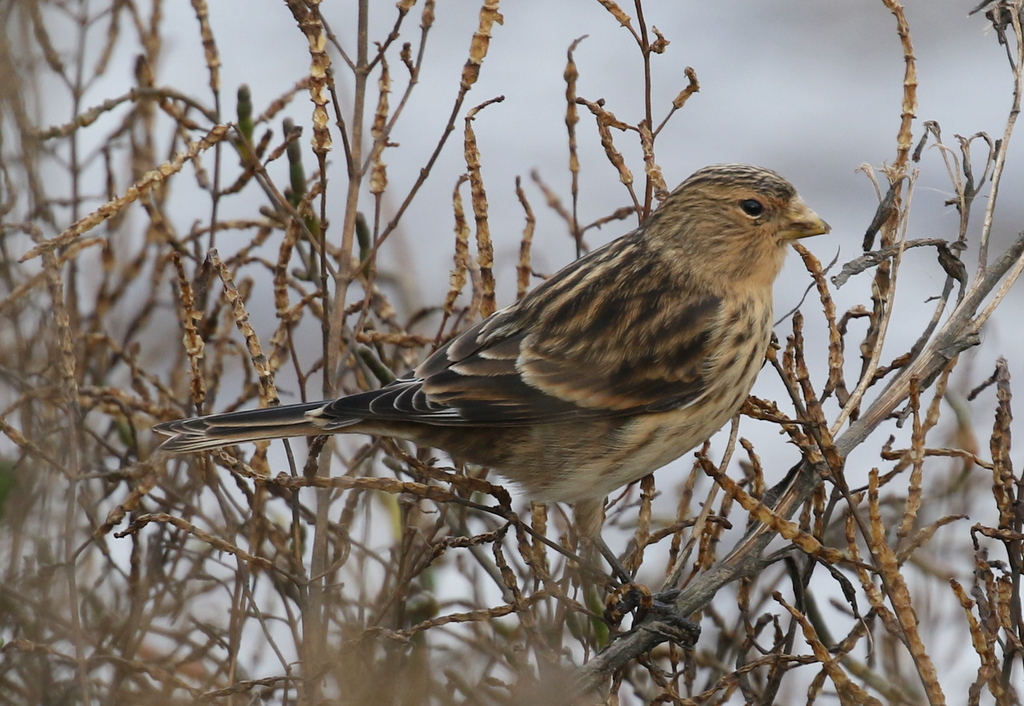
We had a great look at some of the Twite as they fed, although it was hard to see all the rings with them down in the vegetation. Fortunately, two of them had already been reported and we had got enough information to identify the third. They were all ringed in Derbyshire, two of them in the spring and one back in 2016. The latter bird spent last winter here too.
It is great to be able to contribute sightings, as they are helping us to learn more about these birds, where they spend the winter and how they move. The Pennines breeding population of Twite has dropped sharply in recent years, and they are much more scarce here in winter than they used to be as a consequence.
There were not many waders here now, perhaps because it was just after low tide. There were several Redshanks in the various channels we checked. We walked up along the seawall as far as the corner and looked out across the harbour. There were plenty of Shelducks out on the saltmarsh, and we noticed a large flock of Brent Geese flying out over the shore line beyond the dunes. A flock of Linnets circled round overhead and a few dropped down to drink at the puddles on the bank.
It was time for lunch now, so we headed round to Titchwell. There were a few finches on the feeders, including one or two Greenfinches which are always good to see these days. A Coal Tit came in too. After lunch, we headed out to explore the reserve.
In the winter, it is often possible to see a Water Rail in the ditches by the path here. We scanned carefully as we walked along, and quickly found one just below the path. This is the first time we have seen it here this winter. We had a great look at it, as it fed in the water in the bottom, throwing leaves out of the way to see what it could find underneath.
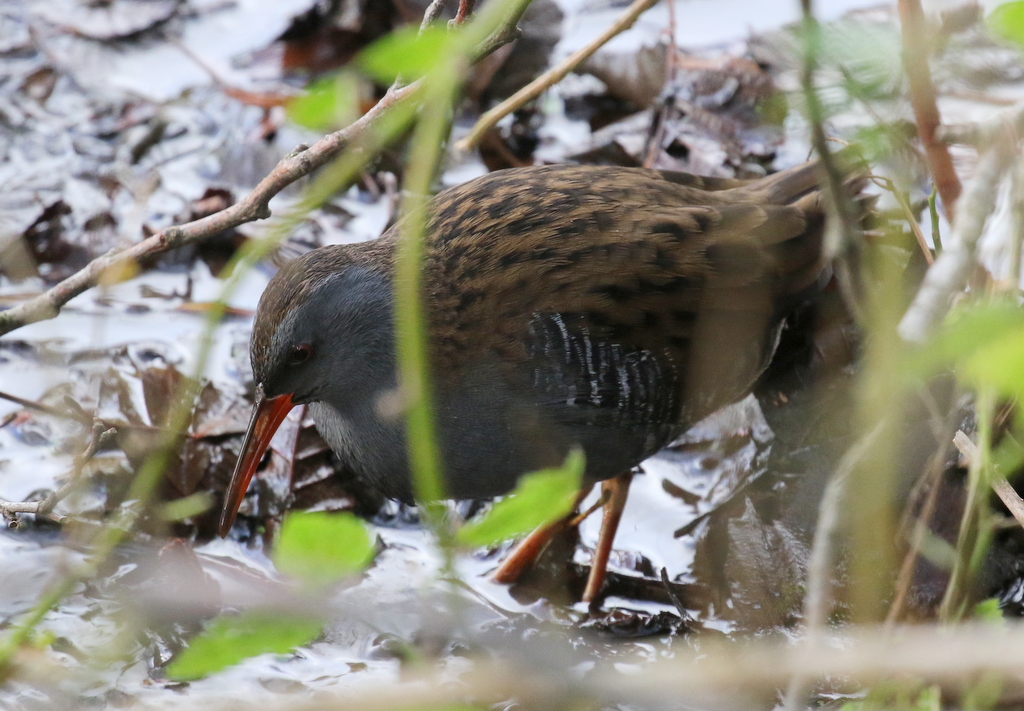
There were a few more birds on the reedbed pool today, so we stopped for a look. As well as several Mallard and Coot, we could see a pair of Gadwall and a single drake Common Pochard in the far corner. Looking across to the back of the reedbed, we could see a surprising number of Marsh Harriers in already. There are over 30 roosting here at the moment apparently, and we counted at least 12 and it was still early afternoon.
When we got to the Freshmarsh, we popped in to Island Hide. The water levels have not yet been raised for the winter, so there were still lots of waders on here. Large flocks of Golden Plover and Lapwings were standing around – separately – in the shallow water. There were several small parties of Dunlin working there way round the muddy edges of the islands and we found a single Ruff on the middle of one of them. Most of the Avocets have departed for the winter, but twelve are currently still trying to remain.
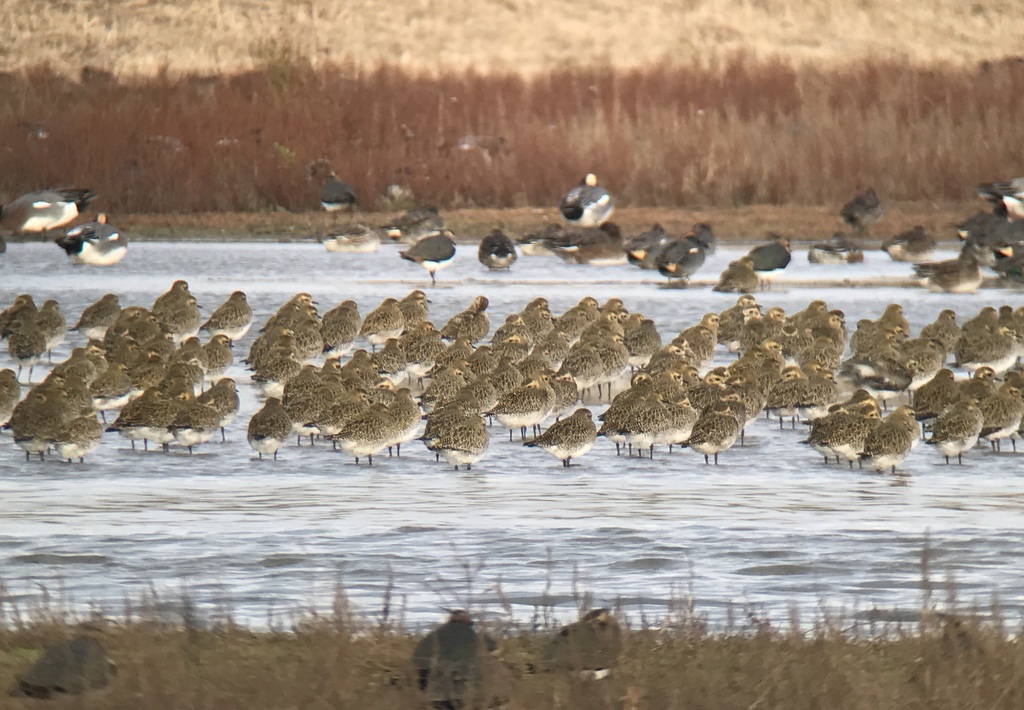
There are lots of Teal still on the Freshmarsh, with several dabbling in the mud in front of the hide. The Wigeon are feeding mainly on the fenced off island, and there were a few Shelduck over the back. But there aren’t many other ducks on here at the moment. A lone Greylag was feeding right outside the window, and small groups of Brent Geese flew in from time to time.
With the light good at the moment, we decided to head straight out to the beach. With the tide out, there was not much on the Volunteer Marsh – a single Curlew feeding quite close to the path, and a few Redshanks along the channel.

With the big tides, the now non-tidal ‘Tidal Pools’ are very full with water. There were a few ducks roosting on the one remaining island. We could see a few Shoveler, which was new for the day, and we eventually found the drake Pintail fast asleep.
The tide was still out and all the waders were still on the beach. Possibly it was a bit less disturbed here today, because there were some big flocks of Knot out on the wet sand to the west. There were good numbers of Grey Plover in with them, and Bar-tailed Godwits closer to the sea beyond. We could see several Sanderlings running around on the shore too.
There had been some good birds on the sea today, so we scanned the water from the shelter of the concrete blocks. We found a couple of Red-breasted Mergansers, a drake Goldeneye and one or two Great Crested Grebes, but we couldn’t immediately see any sign of any divers, other grebes or the Long-tailed Ducks.
We walked down to the mussel beds, to get a better look at some of the waders. We got a nice little group of Knot in the scope, and then a Bar-tailed Godwit. The Knot were rather flighty and kept flying round.

It was exposed to the elements out on the open sand, so we walked back up the beach to the edge of the dunes to scan the sea again. We finally managed to find where the Long-tailed Ducks were, but they were a long way off to the west, half way to Thornham Point, and impossible to see with the light starting to go now. There was a diver and a couple of more interesting looking grebes even further off that way. We did discuss whether we wanted to walk up along the beach to try to see them, but it was getting late now. We decided to head back.
We called in at Parrinder Hide on our way. There were lots of gulls gathering to roost now, and in amongst the Lesser Black-backed Gulls and Herring Gulls, we found an adult Yellow-legged Gull. We hadn’t seen a Common Snipe today, so we scanned along the margins where the reeds have been cut this week, to no avail. Then one flew out of the vegetation on one of the islands and landed in with the Lapwings, before scurrying back in to cover.
The Golden Plover and Lapwings all spooked and whirled round over the Freshmarsh, silhouetted against the last of the light. We couldn’t see what caused it, possibly just a Marsh Harrier drifting over, but they settled down again quite quickly.
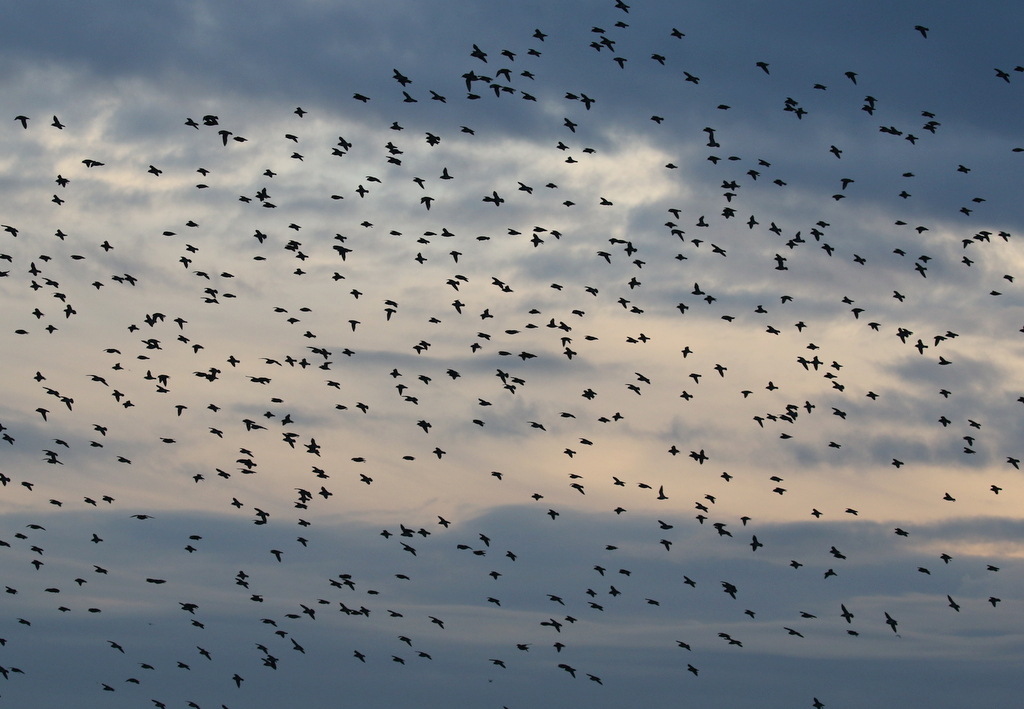
As we walked back along the main path, we looked across to the back of the Freshmarsh to see a small falcon flying fast and low along the bank, a Merlin. It cut the corner over the Freshmarsh and dropped over the top of the bank towards the Volunteer Marsh. We stopped by the reedbed to watch the Marsh Harriers and Little Egrets gathering over the back. More were still arriving, flying in from the west over the path as we made our way towards the trees. Unfortunately, it was time for us to head for home too.
















